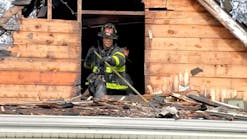Staffing and Activities for Effective Fire Prevention Organizations
The two biggest challenges faced by fire departments and fire prevention organizations around the country are budgets and personnel, specifically, having enough funds and personnel to provide essential fire prevention services.
How can a community build a functioning fire prevention organization? How can the organization prove its value? What programs and features should be offered? Where are the organization’s best efforts and dollars spent? How can the fire prevention organization, programs, staffing and budget be justified? NFPA 1730: Standard on Organization and Deployment of Fire Prevention Inspection and Code Enforcement, Plan Review, Investigation, and Public Education Operations was created to address these challenges. This standard serves as a manual for the establishing, organizing and managing the fire prevention functions of a fire department.
The data
The starting point is the community risk assessment (CRA). The CRA is a three-step process that can be used to determine the priorities and objectives of the fire prevention organization. The three steps for conducting the CRA are to 1) gather information, 2) analyze the data and 3) develop a strategy.
The CRA compiles data from a variety of sources in order to provide a picture of the community and its fire and life safety history. Data includes community demographics, economics, geographical features, fire experience, emergency responses, buildings, structures and hazards present.
The data is then analyzed and evaluated. The analysis and evaluation will identify the specific risks to which a community is exposed. These findings can be added to a risk assessment matrix that classifies hazards based on probability and impact. From this data collection and analysis process, a fire protection and life safety strategy can be formulated that will reduce risk in the community. This strategy is referred to as a community risk reduction (CRR) plan.
The work
The CRR plan outlines the programs and strategies that will be utilized to reduce, mitigate or eliminate the risks posed to the community. The plan will be different for every community; however, common risk reduction elements involve existing building inspections, plan review, origin and cause investigations, and public education. Each of these tasks comes with its own set of challenges and requires a considerable time commitment from fire prevention personnel.
As witnessed by the recent tragedy at the Oakland warehouse fire (“Ghost Ship” fire) and other large loss of life fires, the most critical task of the fire prevention organization is the inspection and code enforcement of existing structures. All structures within a community can be identified as high, moderate or low risk, or critical infrastructure. High-risk structures include healthcare, education, multi-family, detention and assembly occupancies. Critical infrastructure can be defined as those systems, structures or assets that are essential for the community to function. This would include power plants, public safety and water treatment facilities. The higher the risk category, the more frequent and extensive the inspections should be. NFPA 1730 recommends structures identified as high risk be inspected at least annually, and those identified as critical infrastructure be evaluated even more frequently.
Benjamin Franklin said, “An ounce of prevention is worth a pound of cure.” The best fire prevention efforts accomplish this by establishing a complete system of plan review and field inspections. NFPA 1730 provides a framework for conducting these activities.
The plan review process can let a builder or property owner understand the feasibility and expected costs of their project. It also provides a preview of what the fire department can expect to come to their community. The plan review process reveals site access, water supply, construction features and fire protection systems availability. Hazardous processes that take place within the structure, or hazardous materials stored on site, can be discovered in the plan review phase.
Compliance with construction codes and installation standards is ensured through the field inspection activity. Systems are tested for functionality, and the structure and operational features are inspected throughout the process to culminate in the building owner receiving their final Certificate of Occupancy to signify that compliance standards have been met, and the building is safe for occupancy. Fire origin and cause investigations can detect product defects, determine fire cause trends, and prevent arson and related crimes. The data collected from the investigation process can play an important role in CRR.
Origin and cause investigation can be a time-consuming and sometimes slow-moving process. The investigation process includes on-scene time, research and data mining, interviews, report writing, and case preparation time. NFPA 1730 emphasizes the utilization of company officers for the preliminary conduct of fire investigations. If a more in-depth investigation is required, then additional resources can be called in. For departments that are operating at minimum staffing levels, the use of company officers can considerably decrease the workload of the fire investigator and other fire prevention personnel. Time and staff utilization may better be spent training company officers to conduct these initial investigations.
Analyzing the data from the CRA, fire investigations, inspection and the plan review process a community’s unique fire problem can be identified. By identifying root fire causes, and at-risk populations a public education agenda can be set. Whether the population is senior citizens, young children, a college town or the workplace, there is a multitude of existing programs that can be used to effectively educate and reduce risk. Behavior only changes with education.
The personnel
By identifying the risks posed to a community, fire prevention functions activities can be prioritized, and staffing required to complete those tasks can be determined. Using the program and organizational guidance provided in NFPA 1730, the case for staffing and budget requirements can be clearly presented. The annex section of NFPA 1730 provides the following five-step system to determine minimum staffing levels.
Step 1: Outline all services provided by the fire prevention organization. Start the staff needs analysis process by listing all services provided, functions performed and activities conducted. This should be an exhaustive and comprehensive list. The list should include all activities, no matter how many times they are performed or how much time they take.
Step 2: Determine time demand for each task. Determine the amount of time it takes to complete each task, function and activity listed in Step 1. This should include all components, such as preparation time, scheduling, research, conducting the activity, report writing and any follow-up. You will need to determine the time each of these take on an annual basis.
Step 3: Determine total personnel hours required to complete activities. Add up the total amount of hours required for all tasks and activities. If your organization has many different tasks, programs, and functions, these can be divided into groups to simplify, or further analyze the total hours required.
Step 4: Calculate personnel total availability. This formula will determine the amount of hours that each employee will have available. This must account for holidays, vacation, sick, training and other times that the employee will not be available for work.
Step 5: Calculate total number of personnel required to perform tasks. To determine the total amount of full-time employees that are needed to perform all fire prevention functions and tasks, divide the total task hours by the total available work hours. (Total task hours/total available work hours = total personnel required.) Fractional values can be rounded up or down. If the number is rounded up, it can provide reserve capacity and provide some cushion. If the number is rounded down, this could result in overtime or increased workload for personnel.
In sum
The CRA is a critical element, as it serves as the blueprint for the fire prevention organization. It is from the CRA that a strategy for CRR can be developed. The CRA will reveal the risk categories of buildings to determine the number of inspections that need to be performed. The CRA will reveal the number and types of new construction that may be expected in order to determine the level of plan review and field inspections that will be required. The CRA will reveal a community’s fire history and experience to determine the time required to be spent on fire origin and cause investigations. Further, it will reveal at-risk areas and populations to establish a roadmap for public education programs and community offerings.
From the completed CRA, the responsibilities of the fire prevention organization will be realized and an accurate indicator and justification for staffing can be presented. Utilizing the guidance of NFPA 1730, a clear fire prevention program can be developed, its value displayed to the community, and justification for budget and staffing can be tangibly demonstrated.
AARON JOHNSON has been in the fire service for over 11 years and currently serves as fire marshal for Rural/Metro Fire Dept. in south Florida. He can be contacted at his website www.thecodecoach.com.






